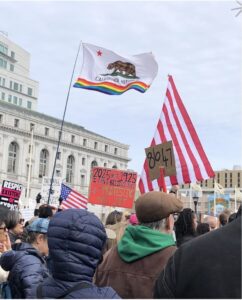
photo courtesy of Mary Vranizan
During his first week back in office, President Donald Trump signed ten executive orders related to immigration, promising to carry out the “largest deportation operation in history.” Since his inauguration on January 20, 2025, immigrant families across the United States have been anxiously living in fear of deportation as they await the aggressive changes. In response, Bay Area organizations have mobilized community efforts—protests, legal measures and advocacy endeavors— to protect their vulnerable, undocumented members’ rights and desires to remain in the United States.
Between January 20 and February 10, Trump and his administration recorded 4,745 deportations; 4,095 were Mexican citizens according to the U.S Immigration and Customs Enforcement (ICE) Removal Operations Statistics. An undocumented Bay Area restaurant worker confessed feeling unsettled. “I’ve always been fearful, but now I feel it more than ever. I can’t help but overthink about what could happen to my family if we were to be separated. These thoughts always fill my mind, and it’s impossible for me to feel settled,” they said.
Trump’s ambitious actions regarding immigration have heightened the aggressive presence of ICE in the Bay Area, spreading fear amongst immigrant communities. Their detention center is located at 9411, 630 Sansome Street, Rm 590 in San Francisco, and receives hundreds of detainees daily. On February 13, another undocumented San Francisco restaurant worker said, “I’ve noticed a change in my community; everything is quiet, and businesses are vacant. Going to work feels like a risk I am unwilling to take. I am not sure how much longer I can live hiding in fear.”
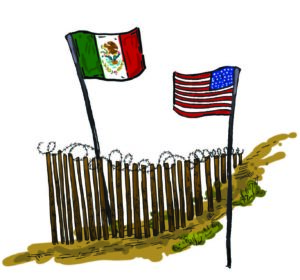
Amidst Trump’s fear-provoking anti-immigration rhetoric and actions, it is important to acknowledge that Presidents Joe Biden and Barack Obama responded to rising anti-immigrant sentiment among voters by implementing policies resulting in mass deportations during their terms.
In 2024, 271,000 immigrants were deported under the Biden Administration, the largest number since the Obama administration reported 409,849 deportations in 2012. “During his term, [Biden] was known as a returner-inchief,” Blaine Bookey, a human rights professor at University of California Law San Francisco and the legal director of the Center for Gender and Refugees Studies, said. Presidents Obama and Biden had higher deportation rates per year than Trump, who detained nearly 250,000 people in his first year in office.
However, Trump’s promise to take the title of deporter-in-chief is expected to reach greater deportations rates, separations, and widespread fear among the nation. In January, ICE’s Director Caleb Vitello ordered agents to aim towards 1,200-1,400 arrests daily. Failing to reach this goal, Vitello was reassigned February 21. Todd Lyons, a member of the Senior Executive Service, was appointed as the new Acting Director on March 10.
According to a 2024 Pew Research Center Report, 5% of California’s population, or an estimated 1.8 million residents, are undocumented. California, one of the eleven sanctuary states—regions such as San Francisco that are quick to denounce ICE activity and limit political and financial cooperation with federal immigration authorities— seeks to support its vulnerable immigrant communities.
The City of San Francisco in particular funds the San Francisco Immigrant Legal and Education Network—a collaboration of organizations including Mujeres Unidas y Activas, the Immigration Center for Women and Children, the African Advocacy Network and the Arab Resource and Organizing Center. They employ their legal and support services to assist the immigrant communities across the Bay Area.
However, “Protecting the American People Against Invasion,” one of Trump’s new Executive Orders, would pause federal funding to sanctuary states. California could suffer significantly under this policy. On January 21, Trump authorized Phase Two militarized deportation efforts in these eight cities: The San Francisco Bay Area, Los Angeles, New York, Chicago, Miami, Seattle, Portland and Austin. These new regulations allow ICE agents to arrest suspected individuals in churches and schools— prior sanctuary establishments— only if federal immigration officials have proper judicial warrants to enter the premises.
Previously under the Biden administration, ICE enforcement guidelines were revised in 2021, limiting arrests at schools, hospitals and houses of worship to only cases involving individuals posing a significant threat.
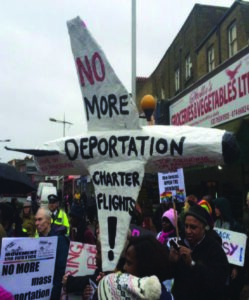
photo courtesy of BAMN
Acting Deputy Secretary of Homeland Security Benjamine Huffman, appointed by Trump, said, “Criminals will no longer be able to hide in America’s schools and churches to avoid arrest.” In response to this statement, an undocumented Colma resident said, “I’ve slowly started learning how to speak English, and I’m proud of the progress I have made in living and working here. I can’t go back.”
In response to Trump’s hostile deportation agenda, Bay Area activists and advocacy groups are ramping up their efforts to protect immigrant rights. Organizations Red cards available at the LWHS lobby. photo courtesy of Public Domain like La Raza Centro Legal, the Immigration Rights Commission, and the Catholic Charities Removal Defense Team are offering legal assistance, while grassroots protests led by organizations such as By Any Means Necessary have gained traction. A result of this was the recent “Day Without Immigrants” on February 3rd which amassed hundreds of participants across the Bay Area, including undocumented individuals and those in solidarity with vulnerable communities.
A Bay Area restaurant worker who participated in the “Day Without Immigrants” detailed his reasons for joining the fight against deportation. As a father of five who has been living in Richmond for the past 11 years, he said, “My children are my everything, and I wouldn’t be able to live thinking that I cannot take care of them. I have sacrificed everything to provide them with opportunities that I never had.”
A legal advocate for a local nonprofit who works to protect undocumented children and reunify families after deportation spoke on condition of anonymity. “The number one shift is the rhetoric, just the vilification, dehumanization of immigrants, and the xenophobia and racism, that oozes from every single document and statement…you didn’t see that under the Biden administration,” they said.
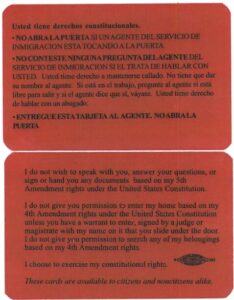
photo courtesy of Public Domain
They stressed the critical role of local organizations like the Immigrant Legal Resource Center, which provides legal education and distributes “red cards” with know-your- rights information to undocumented individuals. These cards, which can be found in public spaces like Lick-Wilmerding High School’s lobby, help people assert their rights during encounters with ICE.
With the harsh implementations of Trump’s new immigration policies, LWHS is bracing for the enforcement efforts to best support and educate their community. On the faculty in-service day on Friday, February 21, founder of the Immigrant Legal Resource “The number one shift is the rhetoric, just the vilification, dehumanization of immigrants, and the xenophobia and racism, that oozes from every single document and statement… you didn’t see that under the Biden administration.”
Center and co-director of the USF Immigration & Deportation Defense Clinic, Professor Bill Ong Hing gave a presentation to LWHS faculty about current immigration law and policy, informed them about legal resources for immigrants, and spread awareness about the daunting presence of ICE in the Bay Area.

photo courtesy of Mary Vranizan
As the fight for immigrant rights unfolds, activists emphasize that the struggle is not just about policy—it is about protecting families, preserving communities and upholding the values of justice and inclusion. “This is a moment for action,” an advocate for immigrant families said. “Communities need to stand together, because the fight for immigrant rights affects us all.”





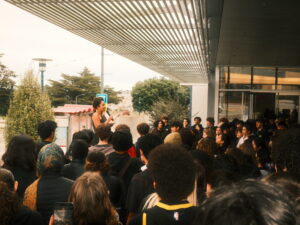

+ There are no comments
Add yours